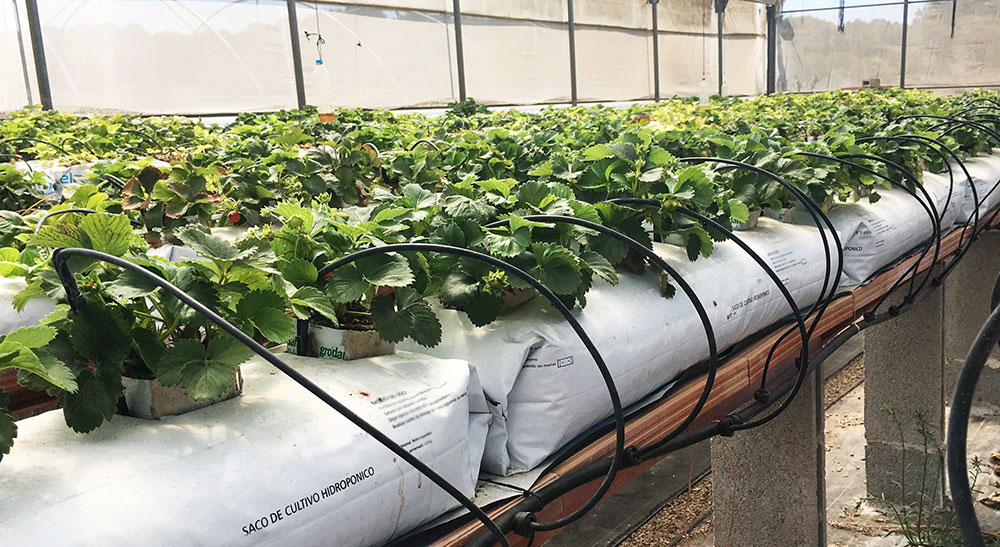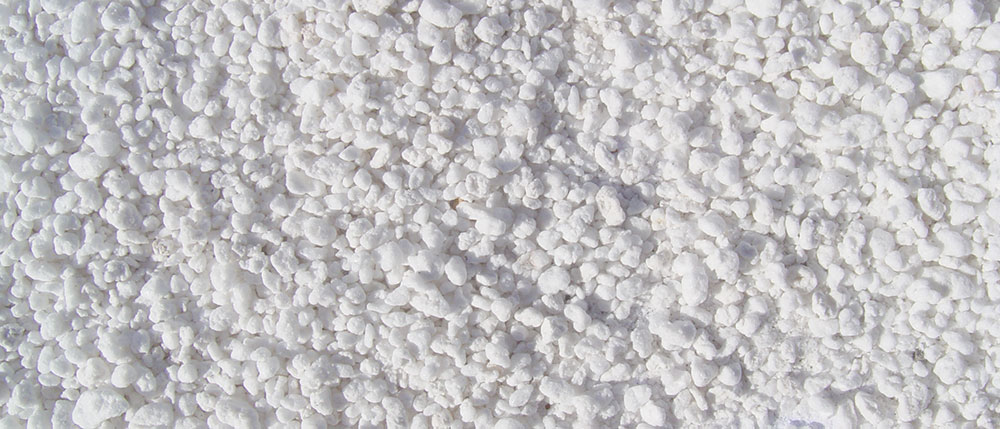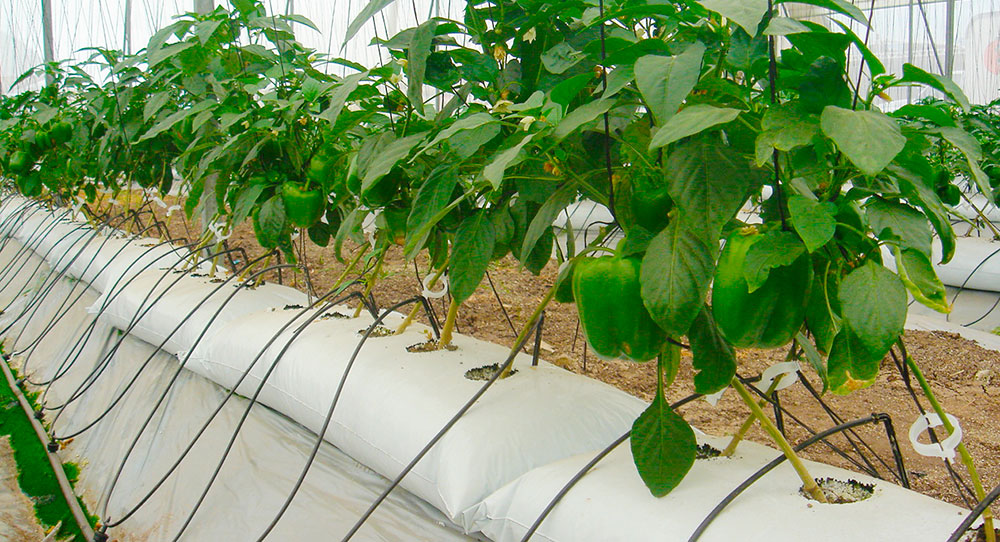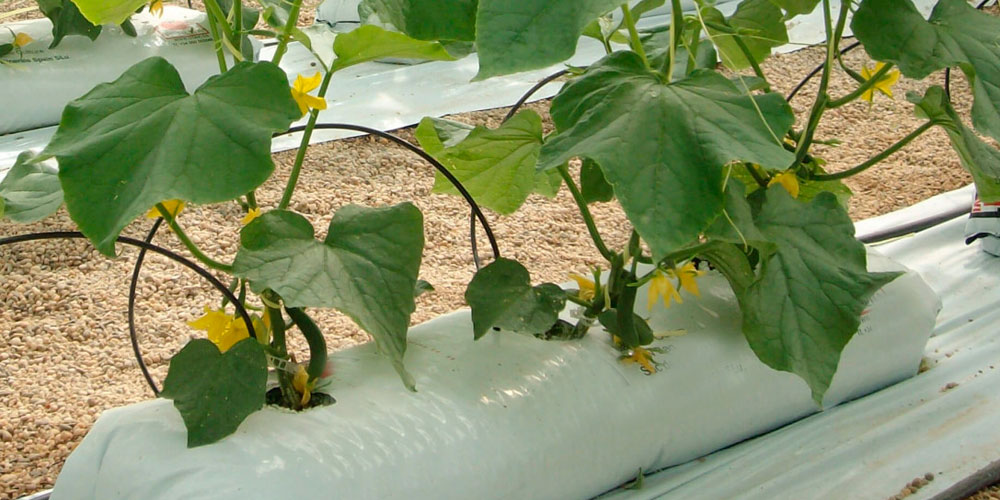Among the materials used in soilless cultivation, also called hydroponic crops, are perlite, rock wool, sand, coconut fiber and some more such as zeolite or gravel, but in less volume.
In this article we will focus on perlite, it comes from a natural mineral of the group of rhyolites. As an original material it is the closest thing to a natural glass, devoid of organic remains in its chemical composition and its geological origin comes from underwater volcanic formations during the Tertiary era, which over time have surfaced, forming cones or volcanic chimneys normally.
Basically, in its chemical composition, it is an alumine silicate that may contain traces of other materials. During its underwater formation, when the magma came into contact with the water abruptly, it has also been able to contribute some elements to the composition of the material. To give some examples, they can be particles of potassium, calcium, magnesium, iron, sodium, chlorine, phosphorus, etc. that, depending on the characteristics of the water at that time, can be conditioning in the subsequent uses after its transformation into commercial perlite.
For all that, we must add the quality in the manufacturing processes, so that not all perlites on the market are equal or valid for use in cultivation without soil. In fact, of all the areas of extraction of the base mineral, among the best mines are those of the island of Milos, a small Greek volcanic island in the Aegean Sea, belonging to the Cyclades archipelago. And not all these mines are the same in terms of characteristics of the materials extracted.

Perlite Uses
Once perlite is manufactured as such, its use has multiple variants, among which are the construction to relieve structures, such as thermal insulation, filtration, in decoration, etc. and of course in agriculture.
Within this, it can be applied as a raw material for formulations of substrates intended for the cultivation of ornamental plants, for formulations of substrates for seedbeds, pure form for hydroponic crops, etc. In all cases, perlite must meet minimum qualities so that its functionality as a substrate guarantees its success.
Manufacture of perlite
The process for the manufacture of perlite begins with the extraction of the aforementioned raw material. During its extraction from the mine it is cleaned raw, sediment remains removed and sorted. From there it is transported to the processing plants.
Once there, in the factory, the impurities are selectively removed, a first screening is carried out and it is passed directly to the mill. With the resulting stones, with a size of less than 1.5 centimeters, they are passed through successive grinds until they are broken up to lower sizes.
During the passage through new and different sieving methods and classifications, cuts of granulometries and cleaning of impurities are generated. Until finally, reach the storage silos as raw material prior to its transformation into commercial perlite.
The next step is to transport this prepared raw material, by means of big bags or in bulk in trucks or ships, to the companies that will subject it to a heat treatment by means of expansion furnaces.
In these furnaces, the material comes into contact with a flame at temperatures above 1000ºC that modifies, or rather, transforms its physical-chemical state.

These small particles increase their volume by 10 to 20 times, ending in very light granules. In this process, it changes its color from grayish to intense white, loses all its moisture and its structure is full of pores.
These new perlite particles are again classified by size, clean of dust and stored by specific characteristics to move to their next phase of commercial packaging, according to needs and target market.
Perlite as a substrate for soilless cultivation
Perlite as a substrate for cultivation without soil or hydroponics must be one that meets certain qualities. As progress has been made, not all of them are suitable.
Thus, this perlite must come from mines where the original material does not contain, or its levels are adequate, of particles of iron, sodium, chlorine, etc. that may affect the crop. After its manufacturing process it concludes in a perlite of the highest quality, since for the construction or insulation it serves any, while for the cultivation without soil only serves the best.
Some essential conditions to be suitable are that chemically it must be inert, have a high porosity and aeration capacity, its structure must be consistent, high capacity for water retention and nutrients, must behave stable in acidic or neutral media, and already in its combination of particle sizes, its granulometric distribution is suitable for use.
The use of this perlite as a substrate in hydroponics, can be used indifferent ways. In agriculture we usually call them units of cultivation.
One of them is presented in culture bags in the form of a pillow, normally contained in black and whitebilayer plastic, about 0.2 mm thick and with anti-UVI treatment that allows it to exceed 3.000 hours of sun that guarantees its usability for 2 to 3 years. These can have different capacities: 20, 28, 34, 37, 40, etc. liters depending on the manufacturer and needs of use in the crop. Its length is variable, from 500 to 1.200 centimeters normally, as well as with a volume of 37 or 40 liters (the most commercials). The packaging choice will take into account factors such as: the species to be cultivated, number of planned campaigns or even the slope of the greenhouse…
Another unit of cultivation is in EPS containers: expanded polystyrene. An inocuous material whose properties and technical characteristics allows it to be thermal, light, hygienic and waterproof insulator. The most common containers usually have a volume of 16 to 46 liters and their use is based on parameters such as those mentioned above. Here it highlights its capacity of insulating thermal barrier, both in summer and in winter, correcting up to 5ºC. Temperature margins that in many cases can positively affect the root development of the plant.
Less popular, although often used, are the so-called EPS, polyethylene and polypropylene canals. These canals are used continuously on the ground and are filled with perlite. Its dimensions must take into account the gravitational potential, which directly affects according to the granulometry of the perlite, to avoid rapid desiccation in the upper layers of cultivation.

Fertilizers for perlite cultivation
Starting from the basis that we are facing a totally inert material, the correct choice of fertilizers for the cultivation of perlite is vital.
From planting to the end of cultivation, the nutrition of the plant will be 100% controlled, being different depending on the species and the phenological state of the plant. Also that this must be applied in fertigation, except for specific contributions via foliar if applicable. Therefore, its solubility must be guaranteed to avoid obstructions in the drip system. Note that the nutritional balance to be applied can become different even according to the variety grown. Let us remember that we are dealing with high-yielding crops.
The mother nutrient solutions are made in the tanks located in facilities called irrigation heads, there are several of them to avoid that in these highly concentrated solutions, different nutrient elements interact and can cause their precipitate. In these facilities are also the climate control and fertigation equipment, irrigation pumps and injectors that doses the fertilizers.
JISA has been developing a complete catalog of fertilizers for use in hydroponics. Fertilizers specialized in plant nutrition, as well as agricultural biostimulants designed to act in strategic moments of the crop that allow to obtain its maximum profitability.
As an added value to the farmer, he/she has the advice of JISA’s technical commercial team that, with its training and experience, can analyze and are able to develop the correct fertilizer plan for each case, as well as the solutions to problems that may arise. Note that the substrate is a base factor of cultivation, but so are the variables of the type climatic and sanitary conditions, for instance.
Can crops be grown with zero perlite residue?
The perlite used in hydroponic cultivation, may contribute to an agriculture respectful with the environment and free of residues. On the other hand, the types of phytosanitary products used are a limiting factor.
On the part of the substrate, perlite is a natural material, without treatments, additives, or contains undesirable elements and is totally inert. After the use it can be 100% recyclable.
During cultivation, the use of fertilizers in fertigation, can contribute to an agriculture respectful with the environment and free of residues. JISA has developed a complete catalogue with plant biostimulants within its specialties of organic fertilizers, algae extract, amino acids, special biostimulants and microorganisms; Soil improvers in humic acids and salinity correctors; Plant nutrition in liquid foliar fertilizers, solid foliar fertilizers, crystalline fertilizers, chelated and deficiencies correctors; and ecological fertilizers in which ECO solutions are grouped for all the needs in agronutrition in its different stages of cultivation.
